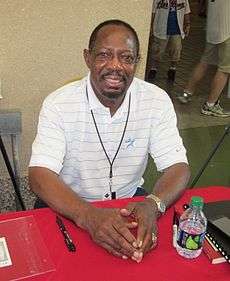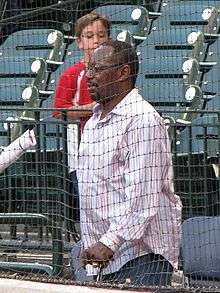Jimmy Wynn
| Jimmy Wynn | |||
|---|---|---|---|
 Wynn in 2011 | |||
| Outfielder | |||
|
Born: March 12, 1942 Hamilton, Ohio | |||
| |||
| MLB debut | |||
| July 10, 1963, for the Houston Colt.45s | |||
| Last MLB appearance | |||
| September 27, 1977, for the Milwaukee Brewers | |||
| MLB statistics | |||
| Batting average | .250 | ||
| Home runs | 291 | ||
| Runs batted in | 964 | ||
| Teams | |||
| Career highlights and awards | |||
| |||
James Sherman Wynn (born March 12, 1942), nicknamed "The Toy Cannon", is an American retired professional baseball player who had a 15-year career with the Houston Colt .45s / Astros and four other teams, primarily as a center fielder. Wynn's nickname was "The Toy Cannon" because his bat had a lot of "pop" for his small size (5 ft 10 in (1.78 m), 160 lb (73 kg)).
Professional career
Minor Leagues
His career started in 1962 when the Cincinnati Reds signed him as an amateur free agent. He played that season for the Tampa Tarpons in the Florida State League. He played mostly at third base, batting .290 with fourteen home runs. After the season, he was drafted by the then Houston Colt .45s in the 1962 first-year player draft.
Houston Astros (1963–1973)
Wynn began the 1963 season with the Double-A San Antonio Bullets in the Texas League, and while there split his time between shortstop and third base while batting .288 with 16 home runs in 78 games. He was promoted to the major leagues in July, and made his major league debut on July 10. Starting at shortstop, he went 1-for-4 with a stolen base. He split his time during the rest of the season between shortstop and the outfield, most often playing left field. He finished the season having played in 70 games, having 61 hits, four home runs, 27 RBIs, four stolen bases and a .244 batting average.
Having struggled defensively at shortstop, Wynn was converted to a full-time outfielder in 1964. He opened the season as the Colt .45s starting center fielder, but was sent back to the minor leagues in June, with Mike White taking over. He was called up in September, and finished the season starting in center field. He finished the season having played 67 games, with 49 hits, five home runs, 18 RBIs, five stolen bases, and a .224 batting average.
He played his first full season the following year, playing 157 games; accordingly, he had 155 hits, 22 home runs, 73 RBIs, 43 stolen bases and a .275 batting average and a .371 on-base percentage.
His 1966 season ended abruptly after 105 games after breaking his left arm crashing into the outfield wall at Connie Mack Stadium chasing down a Dick Allen fly ball that resulted in a game-winning, inside-the-park home run for Allen and the Philadelphia Phillies in the bottom of the 10th inning on August 1, 1966.[1][2][3][4][5] The injury ended his season. He had 107 hits, 18 home runs, 62 RBIs, 13 stolen bases, a .256 batting average and .321 OBP.[6]
His 1967 season was a return to form, as he played 158 games, having 148 hits, 37 home runs (a career high), 107 RBIs, 16 stolen bases, a .249 batting average and a .331 OBP, was named to his first ever All-Star Game and he finished 11th in the MVP voting, being edged out by Hank Aaron (and his 39 home runs) in the home run chase for the season in the final days of the season; it has been speculated that Wynn may have lost a substantial number of home runs to the lengthy fences in the Astrodome, while Aaron played in the more homer-friendly Atlanta–Fulton County Stadium. Aaron himself commented that he considered Wynn the season's home run champion.[7] Perhaps Wynn's most famous home run came on June 10 of that 1967 season at Crosley Field. The shot, which came in the eighth inning of the Astros' 8–3 loss to the Cincinnati Reds, cleared the 58-foot scoreboard in left-center field and bounced onto Interstate 75 outside the stadium. Five days later, Wynn became the first Houston batter to hit three home runs in one game as his Astros defeated the San Francisco Giants 6–2 at the Astrodome. In the first game of a doubleheader against the Pittsburgh Pirates one month later, on July 23, Wynn hit another tape measure home run, the ball clearing Forbes Field's center-field wall 457 feet from home plate.[8]
The following season, he played in 156 games while having 146 hits, 85 runs, 26 home runs, 67 RBIs, 11 stolen bases with a .269 batting average and a .376 OBP, although he walked 90 times and struck out 131 times. His 1969 season had its highs and lows, as he played in 149 games while having 133 hits, 113 runs, 33 home runs, 87 RBIs, 23 stolen bases, 148 walks (a career high) for a .269 batting average and a .436 OBP (a career high), although he struck out 142 times (a career high). He finished 15th in the MVP balloting. The following year, he played in 157 games while having 156 hits, 82 runs, 27 home runs, 88 RBIs, 24 stolen bases, 106 walks, 96 strike outs, and a .282 batting average with a .394 OBP. In the 1971 season, he played in 123 games (his least since 1966), having 82 hits, 38 runs, seven home runs, 45 RBIs, 10 stolen bases, 56 walks, 63 strike outs, with a .203 batting average and .302 OBP. He returned to form the following season, playing in 145 games while having 148 hits, 117 runs, 24 home runs, 90 RBIs, 17 stolen bases, 103 walks, 99 strikeouts, and a .273 batting average and a .389 OBP. The 1973 season was his final one with the Astros. He played in 139 games, having 106 hits, 90 runs, 20 home runs, 55 RBIs, 14 stolen bases, 91 walks, 102 strikeouts with a .220 batting average and a .347 OBP. On December 6, 1973, he was traded to the Los Angeles Dodgers for David Culpepper and Claude Osteen.
Los Angeles Dodgers (1974–1975)

In his first season with the Dodgers, he played in 150 games, having 145 hits, 104 runs, 32 home runs, 108 RBIs, 18 stolen bases, 108 walks, 104 strikeouts, with a .271 batting average and a .387 OBP. He was named to the All-Star Game that season, while finishing 5th in the MVP balloting and being awarded by the Sporting News with the Comeback Player of the Year Award in helping the Dodgers win the National League pennant. In the 1974 NLCS, he had just two hits in 10 at-bats, although he walked nine times and had 2 RBIs and scored four runs while they beat the Pittsburgh Pirates in four games. In the 1974 World Series, he went 3-for-16 while having 2 RBIs and his only postseason home run was off Rollie Fingers in the 9th inning of Game 1 in a losing cause.
Wynn started 1975 well, although a bad shoulder injury limited his effectiveness at the plate and making throws from center field, thus he was moved to left field. In his second (and last season) with the Dodgers, he played in 130 games, having 102 hits, 80 runs, 18 home runs, 58 RBIs, seven stolen bases, 110 walks, 77 strikeouts with a .248 batting average and .403 OBP. He was named to the All-Star Game, his third and final selection. On November 17, 1975, he (along with Lee Lacy, Tom Paciorek and Jerry Royster) were traded to the Atlanta Braves for Dusty Baker and Ed Goodson.
Atlanta Braves (1976)
In his only season with the Braves, he played in 148 games, having 93 hits, 75 runs, 17 home runs, 66 RBIs, 16 stolen bases, 127 walks, 111 strikeouts, with a .207 batting average and a .377 OBP. On November 30th, he was purchased by the New York Yankees.
New York Yankees / Milwaukee Brewers (1977)
He spent the final year of his career mainly as a designated hitter for the New York Yankees and Milwaukee Brewers, having been released by the Yankees on July 14 and signed as a free agent by the Brewers 12 days later. He played in 30 games for the Yankees and 36 for the Brewers, making for a total of 66 games, garnerong 34 total hits, one home run, 13 RBIs, four stolen bases, 32 walks, 47 strikeouts, with a .175 batting average and a .289 OBP. On October 28, he was released by the Brewers.
After retirement
| Jimmy Wynn's number 24 was retired by the Houston Astros in 2005. |
His number 24 was retired by the Astros on June 25, 2005, when the Astros played the Texas Rangers. Jason Lane, who wore Wynn's 24 before the ceremony, changed his number to 16 as a result.
Wynn previously served as a post-game analyst on Houston Astros television broadcasts on FSN Houston. He has also served as a community outreach executive for the team.
Wynn was a player who walked a lot, giving him a very high on-base percentage. Moreover, he played in the 1960s, a low run-scoring era, as well as in the Astrodome, a low run-scoring park. This has led to many statistical analysts (or proponents of sabermetrics) to argue that Wynn was a very underrated player who may even deserve induction into the Baseball Hall of Fame. In his only year on the ballot, he received zero votes, though he remains eligible for future Veterans Committee consideration. [9]
In popular culture
In the 1995 film Apollo 13, television footage of Wynn rounding third base is shown as the Apollo astronauts broadcast what they erroneously think is a live feed to a national audience.
See also
References
- ↑ "Philadelphia Phillies 6, Houston Astros 5". retrosheet.org. August 1, 1966. Retrieved August 29, 2015.
- ↑ "Phillies Sneak by Astros". Milwaukee Sentinel. Associated Press (AP). August 2, 1966. p. 2, part 2. Retrieved August 29, 2015.
- ↑ "Phils Nip Astros On Allen's HR: Callison Raps Pair In 6-5 Victory; Jim Wynn Hurt". Pittsburgh Post-Gazette. Associated Press (AP). August 2, 1966. p. 16. Retrieved August 29, 2015.
- ↑ "Allen's Home Run Keeps Astros Losing". Milwaukee Journal. August 2, 1966. p. 14, part 2. Retrieved August 29, 2015.
- ↑ "Wynn 11th Astro to Be Injured". Milwaukee Sentinel. Associated Press (AP). August 3, 1966. p. 4, part 2. Retrieved August 29, 2015.
- ↑ "1966 Batting Gamelogs". baseball-reference.com. sports-reference.com. Retrieved August 29, 2015.
- ↑ "Jim Wynn Tribute". astrosdaily.com. Retrieved August 29, 2015.
- ↑ https://www.youtube.com/watch?v=Y4Cn6qusV3c
- ↑ "Hall of Merit Discussion: Jimmy Wynn". baseballthinkfactory.org. Retrieved August 29, 2015.
External links
- Career statistics and player information from MLB, or ESPN, or Baseball-Reference, or Fangraphs, or The Baseball Cube, or Baseball-Reference (Minors)
- Baseball Evolution Hall of Fame – Player Profile